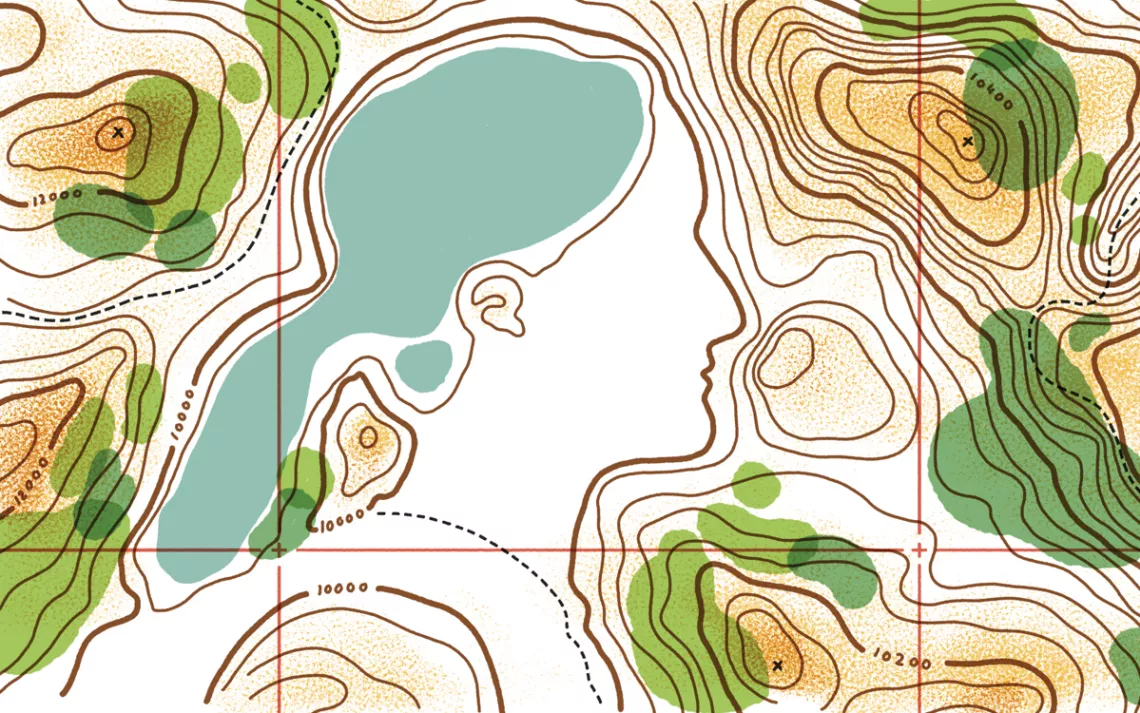On Finding a Way Through the Wilderness
Middle age is a chance to reorient yourself

Illustration by Anine Bösenberg
The dry shrubland of Colorado's Front Range foothills encourages a certain downward concentration. Rattlesnakes curl under mountain mahogany. Jagged rocks could break an ankle. I've run and hiked these trails for 30 years, and sometimes I watch so closely for hazards on the ground that I miss subtle changes in the landscape—the varying shades of green after spring rains and summer monsoons, the birdsong shifts of avian migration, the cumulus clouds of morning transforming into cumulonimbus thunderheads by afternoon. Maybe these spaces have become too familiar. Maybe I take them for granted.
This year, I trained as a wilderness volunteer for the US Forest Service to help conserve these places and others nearby: the Rawah, Comanche Peak, and Neota Wildernesses, the fire-ravaged Poudre Canyon, the Forest Service land outside Rocky Mountain National Park. That means I might have to give a precise location to a search-and-rescue crew or note exactly where a fallen tree is blocking a trail, so I signed up for a map and compass class, just as a refresher.
Middle age can be an embarrassing life stage, and not just because the term midlife crisis is typically used to describe ridiculous behaviors. I enjoy a certain confidence I didn't have before, which makes it awkward to be confronted with things I think I know but don't, like how to get my bearings with a compass. Luckily, middle age also comes with a higher tolerance for discomfort and an expansive self-acceptance, and both facilitate humility.
I was reassured when nobody else in the class could take a compass reading either. Our instructor, Gerry, showed us how to align the compass and point the directional arrow at notable landmarks—reservoirs, seeps, visible peaks—to get our bearings. We added eight degrees to the numbers on the housing to get the magnetic declination, which accounts for the fact that magnetic north moves around 34 miles a year. Toward Siberia. Inexplicably faster all the time. This was news to me.
Once we had bearings down, we hiked a half mile. Gerry passed each of us a map and asked, "Where are we?" It was a moment of disconnect. I knew the trailhead, the trail name, and the distance traveled. I knew exactly where I was. And I didn't. We triangulated our position using bearings from a small pond, a flat slope, and a rocky knob and drew lines through each point. (Being able to recognize these landmarks in life and on maps is, Gerry said, our own due diligence.) Eventually, with patience, all my lines crossed right where I stood.
Mostly I like getting older, not that I have any choice in the matter. But it is sometimes disorienting to wander the familiar spaces of my life as this new person I've grown into. It's complicated by the fact that, like magnetic north, my landmarks have shifted. I left my teaching job to become a writer. I lost my father to cancer. My children are leaving home. My husband and I, married 24 years, are struggling in ways we did not expect.
I've been feeling a bit lost in my life, and I'm grateful for this new way of knowing where I am and how to find myself, something I would not have appreciated in younger years. My bearings get more accurate the more I practice, though Gerry told me not to worry about being perfect. You just have to be close enough that the search party can rescue you. This was the most important takeaway from the class, reinforcing what I already knew: The people I love would come if I needed them, which means I'm still in the right place. Or at least, I'm close enough.
 The Magazine of The Sierra Club
The Magazine of The Sierra Club



